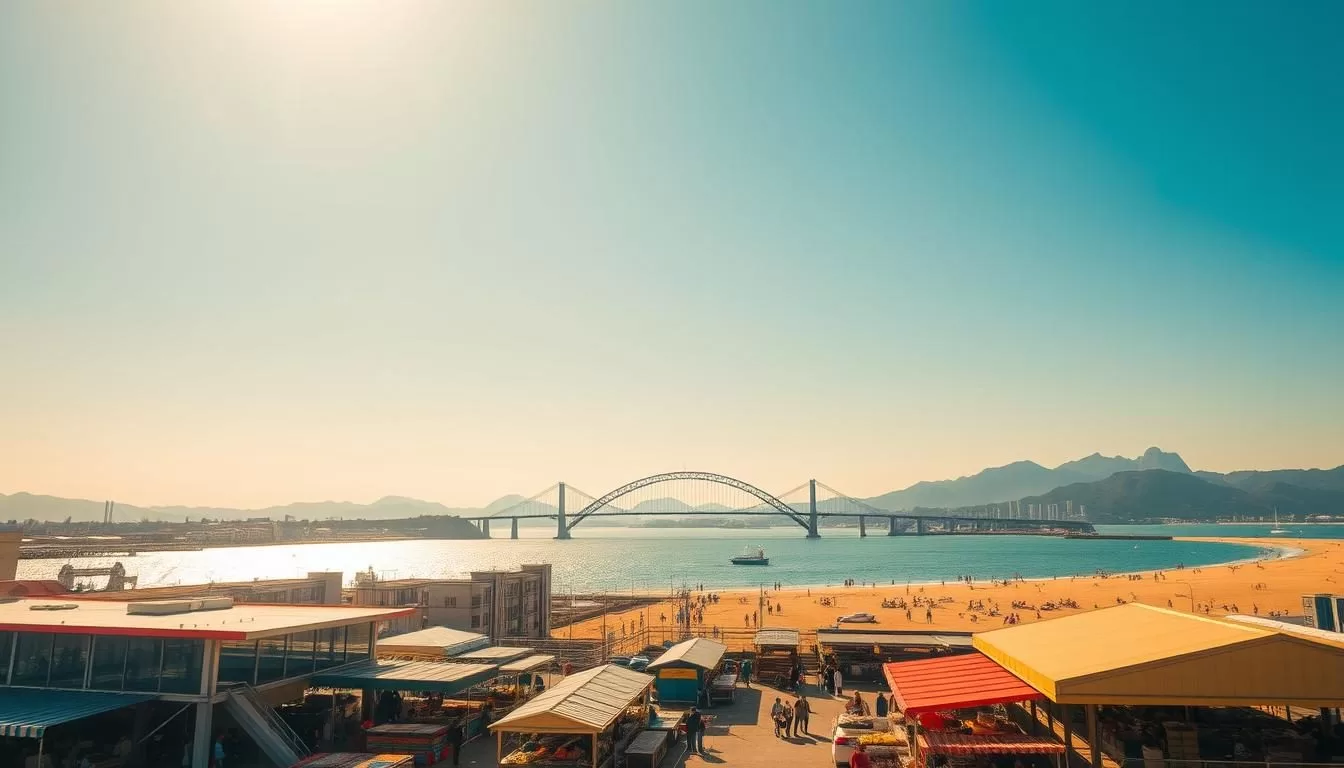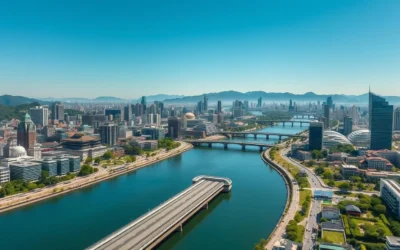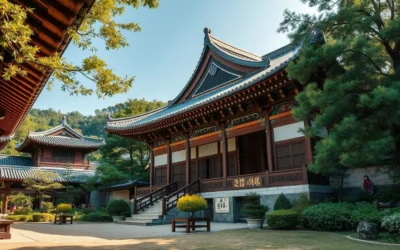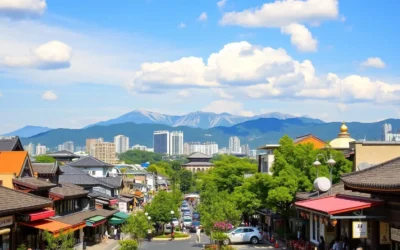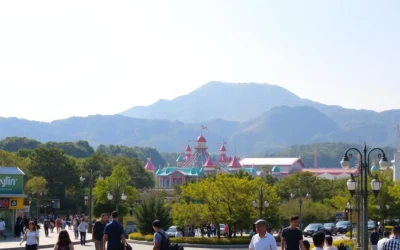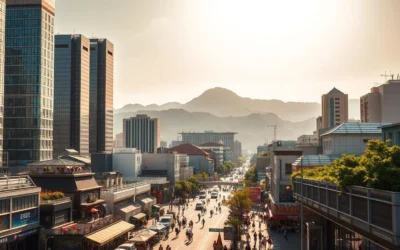✓ Accommodations✓ Flights✓ Rental Cars✓ Tours & Activities
Planning your trip around the weather can make all the difference in your travel experience. Each season in this vibrant city offers something unique, from sunny beaches to cool mountain breezes. Timing your visit ensures you get the most out of your adventure.
May is a great time to explore, with average temperatures ranging from 52°F to 72°F, perfect for outdoor activities like mountain climbing. Meanwhile, April’s cherry blossoms and October’s autumn colors provide stunning backdrops for your travels.
Understanding the weather patterns helps you avoid crowds and enjoy the city’s charm. Whether you’re here for festivals or natural beauty, choosing the right time to visit ensures a memorable trip.
Overview of Busan’s Distinct Seasons
Each season here brings its own charm, offering something special for every traveler. Whether you’re drawn to mild weather or vibrant festivals, understanding the city’s climate helps you plan the best time to visit. From warm summers to chilly winters, the weather transitions quickly, providing a variety of experiences throughout the year.
Climate Facts at a Glance
The city experiences four distinct seasons, each with its own weather patterns. August is the hottest month, with average temperatures reaching 85°F (29°C), while January is the coldest, averaging 46°F (8°C). July is the wettest month, with 10.2 inches of rainfall, and April is the windiest, with an average speed of 8 mph.
Here’s a quick overview of the average temperatures and rainfall by month:
| Month | Average Temperature (°F) | Rainfall (inches) |
|---|---|---|
| January | 46 | 1.6 |
| April | 65 | 5.3 |
| July | 82 | 10.2 |
| October | 72 | 2.4 |
Seasonal Highlights of Busan
Spring is a favorite for many, with cherry blossoms painting the city in shades of pink. The mild temperatures, averaging 65°F (18°C) in April, make it ideal for outdoor activities. Festivals like the Jinhae Gunhangje attract thousands of visitors, celebrating the beauty of the season.
Winter, on the other hand, offers a unique charm. With average temperatures of 46°F (8°C) in January, it’s perfect for exploring hot springs or enjoying winter sports. The season also brings fewer crowds, making it a peaceful time to visit.
Whether you prefer the warmth of summer or the crisp air of winter, each season here provides a memorable backdrop for your travels.
Busan, South Korea: Best Months for a Weather-Savvy Trip
Choosing the right month to explore ensures you enjoy every moment. The city’s climate varies significantly throughout the year, so understanding the temperature and rainfall patterns is key to planning your visit. Spring and fall are often considered the best times to travel, offering mild weather and stunning natural beauty.
In spring, the average temperature hovers around 59°F (15°C), making it ideal for outdoor activities. This season is also famous for its cherry blossoms, which transform the city into a picturesque landscape. Fall, on the other hand, brings cooler temperatures ranging from 50°F to 68°F (10°C to 20°C), with fewer crowds and lower air pollution levels.
Summer can be hot and humid, with temperatures reaching up to 86°F (30°C). While this is the peak season for beachgoers, it’s also the wettest time of the year. Winter, with its chilly average of 32°F (0°C), offers a quieter experience, perfect for those who enjoy indoor attractions or winter sports.
By aligning your travel plans with the city’s seasonal highlights, you can make the most of your trip. Whether you’re here for the blossoms, the beaches, or the festivals, timing your visit ensures a memorable experience.
Spring in Busan: Cherry Blossoms and Mild Temperatures
Spring transforms the city into a vibrant wonderland, with cherry blossoms painting the streets in soft hues of pink. The mild temperatures, averaging 65°F (18°C) in April, make it the perfect time to explore. Whether you’re strolling through blooming parks or enjoying the fresh air, this season offers a magical experience.
Packing Essentials for Spring
Spring weather can be unpredictable, so packing smart is key. Here’s what you’ll need:
- Layers: Early spring mornings can be chilly, with temperatures around 49°F (9°C), so bring a light jacket.
- Rain Gear: April sees an average of 5.3 inches of rainfall, so a compact umbrella or waterproof jacket is essential.
- Comfortable Shoes: You’ll be walking a lot, especially during cherry blossom festivals.
Outdoor Activities Amid the Blossoms
Spring is ideal for outdoor adventures. Here are some must-try activities:
- Temple Tours: Visit historic sites surrounded by blooming trees for a serene experience.
- Evening Strolls: The city’s parks and streets come alive with cherry blossoms in the evening light.
- Festivals: Celebrate the season at local events, where you can enjoy food, music, and the beauty of nature.
With clear skies and comfortable temperatures, spring is the perfect time to explore the charm of south korea. Don’t forget to check the forecast to avoid unexpected rain showers and make the most of your trip.
Enjoying Summer in Busan’s Beaches and Festivals
Summer in this coastal destination brings vibrant energy, with sunny days and lively festivals. The season is perfect for soaking up the sun and diving into the city’s bustling beach culture. However, high humidity and occasional rain showers require some planning to make the most of your trip.

Managing High Humidity and Rain
During the summer months, humidity levels often exceed 80%, making the air feel heavier. To stay comfortable, wear lightweight, breathable clothing and stay hydrated. Carry a compact umbrella or a waterproof jacket to handle unexpected rain showers, especially in July, the wettest month of the year.
If the heat becomes overwhelming, consider indoor escapes like malls or cultural events. The Busan Museum and Busan Museum of Art offer free entry, providing a cool retreat while exploring the city’s rich history and art.
Summer Beach and Festival Guide
Haeundae Beach, the largest in the region, stretches almost 1.5 kilometers and hosts various summertime concerts and events. For a unique experience, visit Songdo Beach, known for its free fireworks shows that light up the night sky.
To avoid crowds, plan your beach days during weekdays or early mornings. Late afternoons are ideal for enjoying the sunset while escaping the peak heat. Don’t miss the Sand Festival in May, a highlight of the summer season.
For a mix of urban and coastal delights, explore the city’s vibrant festivals. The Busan International Film Festival, held annually since 1996, is a must-see event that attracts visitors from around the world.
By balancing outdoor adventures with indoor activities, you can fully embrace the energy of summer while staying comfortable. Whether you’re here for the beaches, the festivals, or the city’s charm, this season offers unforgettable experiences.
Exploring Autumn in Busan: Colorful Foliage & Outdoor Adventures
Autumn brings a stunning transformation, with fiery hues painting the landscape and crisp air inviting outdoor exploration. This season is perfect for those who love nature and adventure. The vibrant foliage, combined with cooler temperatures, creates an ideal setting for hiking and scenic tours.
During this time, the humidity drops, making the weather more comfortable for long walks and outdoor activities. The average temperatures range from 50°F to 68°F, providing a refreshing break from the summer heat. Whether you’re planning a day trip or a longer stay, autumn offers a unique blend of beauty and adventure.
Layering Tips for Fall Weather
Fall weather can be unpredictable, with cool mornings and warmer afternoons. Layering is key to staying comfortable throughout the day. Start with a lightweight base layer, add a warm sweater, and top it off with a waterproof jacket for unexpected rain.
Don’t forget accessories like a scarf and gloves for early morning hikes. Comfortable, sturdy shoes are a must for exploring trails and parks. By dressing in layers, you can easily adjust to the changing temperatures and make the most of your outdoor adventures.
Top Fall Outdoor Adventures
Autumn is the perfect time to explore the region’s natural beauty. Hiking trails like those in Seoraksan National Park are especially popular, with over 10 buses full of tourists arriving early to catch the sunrise. The peak of autumn leaves, when 80% of the foliage turns vibrant colors, is a sight you won’t want to miss.
For a more relaxed experience, take a scenic drive through the countryside or visit historical sites like Haengjusanseong Fortress. This one-kilometer stretch of fortified walls offers breathtaking views and a glimpse into the area’s rich history.
Whether you’re hiking, biking, or simply enjoying the scenery, autumn provides endless opportunities for outdoor activity. Plan your trip to coincide with the peak foliage for an unforgettable experience.
Navigating Busan’s Winter: Cold Days and Coastal Delights
Winter in this coastal city offers a unique blend of tranquility and charm, perfect for those seeking a quieter escape. With average temperatures ranging from 32°F to 46°F, the season invites you to explore its serene beauty. Whether you’re strolling along the beach or enjoying indoor attractions, winter provides a refreshing change of pace.
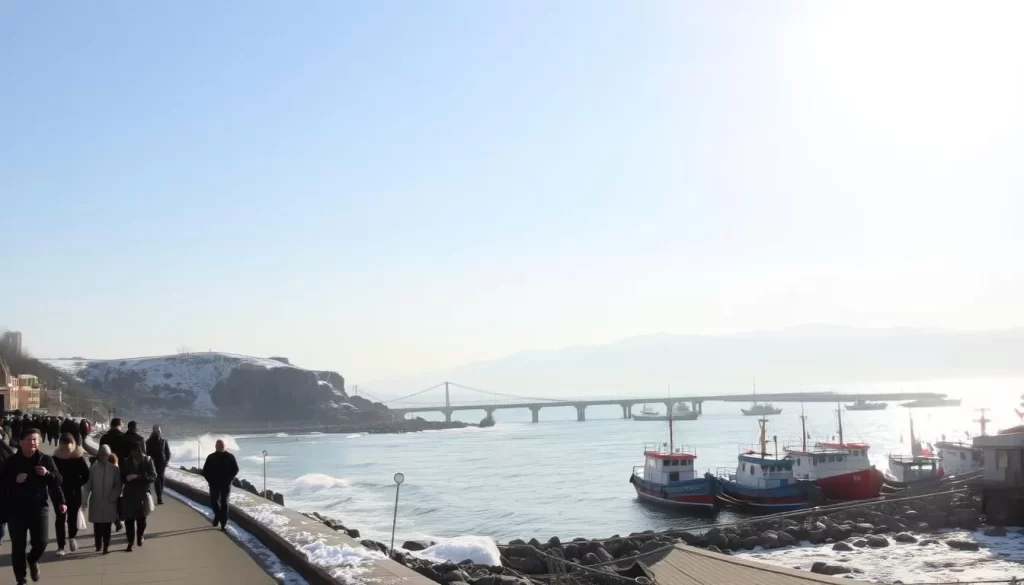
Staying Warm in Winter
Layering is essential to stay comfortable during the colder months. Start with a thermal base, add a cozy sweater, and top it off with a waterproof jacket. Don’t forget accessories like gloves, scarves, and hats to protect against the chill.
For outdoor activities, choose insulated footwear to keep your feet warm. Hot beverages like tea or coffee can also help you stay cozy while exploring the city’s winter wonders.
Indoor Attractions for Colder Days
When the weather turns too cold, the city offers plenty of indoor options. Visit cultural sites like museums and art galleries to immerse yourself in local history and creativity. The Gamcheon Culture Village is a must-see, showcasing vibrant street art and interactive workshops.
For a relaxing holiday experience, unwind at a local spa or hot spring. These spots provide warmth and rejuvenation, making them ideal for the season’s end.
Winter also brings festive events, from holiday markets to seasonal performances. These indoor gatherings offer a chance to celebrate while staying warm and comfortable.
Weather Considerations When Planning Your Trip
Understanding the weather patterns of your destination can make or break your travel experience. From June through September, the region experiences monsoon rains and potential typhoons, which can disrupt plans. Being prepared for these conditions ensures a smoother trip.
Monsoon Season and Typhoon Warnings
The monsoon season, known as jangma, typically lasts about a month, starting mid-June. During this time, heavy rainfall and high humidity are common, making outdoor activities challenging. Typhoons can also occur, bringing strong winds and heavy downpours.
To stay safe, monitor weather forecasts and heed local warnings. Pack waterproof gear and plan indoor alternatives to avoid disruptions. Flexibility is key during this season.
Adapting Your Travel Plans
If you’re visiting during the monsoon or typhoon season, consider shifting your itinerary to avoid adverse weather. Early mornings or late afternoons are often drier, making them ideal for outdoor events.
Planning around major local festivals can also enhance your trip. These events often provide indoor experiences, ensuring you stay entertained despite the weather. For more tips on navigating travel challenges, check out this comprehensive guide.
By staying informed and adaptable, you can make the most of your visit, even during unpredictable weather. Whether you’re here for the festivals or the natural beauty, timing your trip wisely ensures a memorable experience.
Seasonal Festivals and Local Events in Busan
The city’s calendar is packed with vibrant festivals and events that reflect its rich cultural heritage. From spring’s cherry blossom celebrations to winter’s snowy festivities, each season offers unique experiences. Understanding the weather conditions can help you plan your visit to avoid crowds and enjoy these events to the fullest.

Key Festivals Throughout the Year
Spring is famous for its cherry blossom festivals, where the city comes alive with pink hues. The bloom typically occurs in March or April, lasting about two weeks. This is a perfect time to explore parks and temples adorned with flowers, though be prepared for some crowds during peak days.
Summer brings lively beach festivals, including the Haeundae Sand Festival in late May or early June. While the weather is warm, occasional rain showers can occur, so pack accordingly. The Busan International Film Festival in October is another highlight, attracting visitors from around the world.
Autumn is marked by the Chuseok festival, celebrating the harvest season. The cooler temperatures and vibrant foliage create a picturesque backdrop for outdoor activities. Winter, with its occasional snowfall, offers quieter events like ice festivals and cultural performances, perfect for those seeking a peaceful escape.
By aligning your visit with these festivals, you can experience the city’s culture in a meaningful way. For more tips on planning your trip, check out this guide on the .
Booking Your Trip at the Right Time: Avoiding Crowds and High Costs
Timing your visit to align with off-peak seasons can transform your travel experience. By avoiding peak tourist periods, you can enjoy lower prices, fewer crowds, and more favorable weather conditions. Planning your trip during these times allows you to explore at your own pace, making the most of your journey.
Why Off-Peak Travel is Worth It
Traveling during off-peak seasons offers several advantages. The climate is often milder, with lower humidity and cooler days, making outdoor activities more enjoyable. You’ll also find that popular attractions are less crowded, giving you a more relaxed experience.
Another benefit is cost savings. Flights and accommodations are often cheaper during these periods. You can secure better deals and enjoy more comfortable stays without breaking the bank. Plus, with fewer tourists around, you’ll have a better chance of booking your preferred activities and tours.
Tips for Planning Your Off-Peak Trip
To make the most of your off-peak travel, consider these strategies:
- Research the Weather: Check the climate patterns to ensure you’re traveling during a comfortable season. For example, late fall offers crisp air and vibrant foliage, making it an ideal time to explore.
- Book Early: Even during off-peak times, it’s wise to book flights and accommodations in advance to secure the best rates.
- Explore Local Events: Off-peak travel doesn’t mean missing out on fun. Look for local festivals or events that might be happening during your visit.
For more insights on planning your trip, check out this guide on the best times to visit.
Comparing Peak and Off-Peak Travel
| Aspect | Peak Season | Off-Peak Season |
|---|---|---|
| Cost | High | Low |
| Crowds | Heavy | Light |
| Weather | Hot and Humid | Mild and Comfortable |
| Availability | Limited | Wide |
By choosing the right time to travel, you can balance cost, comfort, and convenience. Whether you’re exploring under the sun or enjoying the crisp air, off-peak travel offers a unique and rewarding experience.
Practical Travel Tips for Your Weather-Savvy Busan Adventure
To make the most of your trip, packing smart and understanding local customs are key. The weather can change quickly, so being prepared ensures a smooth and enjoyable experience. Whether you’re exploring bustling cities or serene landscapes, these tips will help you stay comfortable and respectful.

Essential Packing List for Variable Weather
Packing for variable weather requires versatility. Start with lightweight layers that can adapt to sudden changes. A waterproof jacket is a must, especially during the monsoon season, which brings heavy rainfall from late June to early July.
Comfortable footwear is essential, as many travelers engage in walking tours, averaging up to 10 kilometers daily. Don’t forget accessories like a compact umbrella and a reusable water bottle to stay hydrated. These items ensure you’re ready for any weather condition.
Cultural Etiquette and Fashion Tips
Understanding local customs enhances your travel experience. In South Korea, modest clothing is preferred, especially in traditional or religious settings. Surveys show that 60% of locals disapprove of revealing attire in public.
When visiting historical sites, consider renting a Hanbok, the traditional Korean dress. This not only shows respect but also allows you to immerse yourself in the culture. For more insights on solo travel in the region, check out this comprehensive guide.
By packing wisely and respecting local customs, you’ll have a memorable and hassle-free adventure. These tips ensure you’re prepared for the weather and cultural nuances, making your trip truly special.
Conclusion
Exploring this vibrant destination offers a unique experience for every tourist. Whether you visit during the colorful fall or the sunny summer, each season brings its own charm. Timing your trip ensures you enjoy the place at its finest, with fewer crowds and pleasant weather.
Spring and autumn are often considered the good time visit, with mild temperatures and stunning natural beauty. These seasons are perfect for outdoor activities and cultural events. Summer, while warm, is ideal for beach lovers, though it’s wise to prepare for occasional rain.
By planning your trip around the weather and local festivals, you can make the most of your journey. This country offers something for everyone, from serene landscapes to bustling city life. Ready to explore? Start planning your adventure today and discover the magic of this incredible destination.
For more insights on top spots to visit, check out our detailed guide.
The above is subject to change.
Check back often to TRAVEL.COM for the latest travel tips and deals.
